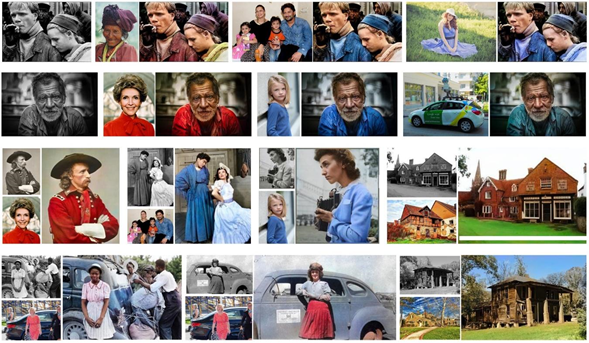Recent Projects
Prof. Jing LIAO
Old Photo Restoration |
|

|
|
|
We propose to restore old photos that suffer from severe degradation through a deep learning approach. Unlike conventional restoration tasks that can be solved through supervised learning, the degradation in real photos is complex and the domain gap between synthetic images and real old photos makes the network fail to generalize. Therefore, we propose a novel triplet domain translation network by leveraging real photos along with massive synthetic image pairs. Specifically, we train two variational autoencoders (VAEs) to respectively transform old photos and clean photos into two latent spaces. And the translation between these two latent spaces is learned with synthetic paired data. This translation generalizes well to real photos because the domain gap is closed in the compact latent space. Besides, to address multiple degradations mixed in one old photo, we design a global branch with a partial nonlocal block targeting to the structured defects, such as scratches and dust spots, and a local branch targeting to the unstructured defects, such as noises and blurriness. Two branches are fused in the latent space, leading to improved capability to restore old photos from multiple defects. The proposed method outperforms state-of-the-art methods in terms of visual quality for old photos restoration. |
|
Image Style Transfer |
|

|
|
|
We propose a new technique for visual attribute transfer across images that may have very different appearance but have perceptually similar semantic structure. By visual attribute transfer, we mean transfer of visual information (such as color, tone, texture, and style) from one image to another. For example, one image could be that of a painting or a sketch while the other is a photo of a real scene, and both depict the same type of scene. Our technique finds semantically-meaningful dense correspondences between two input images. To accomplish this, it adapts the notion of "image analogy" with features extracted from a Deep Convolutional Neutral Network for matching; we call our technique Deep Image Analogy. A coarse-to-fine strategy is used to compute the nearest-neighbour field for generating the results. We validate the effectiveness of our proposed method in a variety of cases, including style/texture transfer, color/style swap, sketch/painting to photo, and time lapse. |
|
Exemplar-based Colorization |
|

|
|
|
We propose the first deep learning approach for exemplar-based local colorization. Given a reference color image, our convolutional neural network directly maps a grayscale image to an output colorized image. Rather than using hand-crafted rules as in traditional exemplar-based methods, our end-to-end colorization network learns how to select, propagate, and predict colors from the large-scale data. The approach performs robustly and generalizes well even when using reference images that are unrelated to the input grayscale image. More importantly, as opposed to other learning-based colorization methods, our network allows the user to achieve customizable results by simply feeding different references. In order to further reduce manual effort in selecting the references, the system automatically recommends references with our proposed image retrieval algorithm, which considers both semantic and luminance information. The colorization can be performed fully automatically by simply picking the top reference suggestion. Our approach is validated through a user study and favorable quantitative comparisons to the-state-of-the-art methods. Furthermore, our approach can be naturally extended to video colorization. Our code and models will be freely available for public use. |
|




